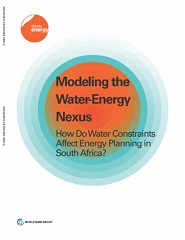Modeling the water-energy nexus: how do water constraints affect energy planning in South Africa?
 This research focuses on incorporating a representation of water supply and infrastructure costs into an energy systems model (SATIM-W) to better reflect the interdependent nature of the energy-water nexus in South Africa and the water supply challenges facing the energy system. The research methodology developed embeds the various water supply options in a least cost optimization energy planning tool, so that the cost of water is captured. A key feature of the developed SATIM-W model is that it regionalizes power generation, refining, and energy resource supply, thereby introducing a spatial dimension to the water demands of the energy sector. It also contains a regionalized structure of the basins and delivery infrastructure that would be required to supply the energy sector and assesses the impact of meeting those needs on the cost of supplying water. The results of this investigation demonstrate the process and type of tools that can be employed to examine the energy-water nexus in a national level planning context, and the insights that can be gained from water-smart energy planning. A number of relevant policy scenarios in South Africa were explored, and the results show that specific energy sector policies can have significant implication for both new investment in water supply infrastructure and in some cases can lead to stranded energy and water investments, reinforcing the importance of planning these sectors through a nexus approach. This case study is the first time the cost of water supply has been assessed in a sector wide energy supply expansion plan. By documenting the methodology, the authors aim to help energy sector planners and modelers properly incorporate water constraints in their work.
This research focuses on incorporating a representation of water supply and infrastructure costs into an energy systems model (SATIM-W) to better reflect the interdependent nature of the energy-water nexus in South Africa and the water supply challenges facing the energy system. The research methodology developed embeds the various water supply options in a least cost optimization energy planning tool, so that the cost of water is captured. A key feature of the developed SATIM-W model is that it regionalizes power generation, refining, and energy resource supply, thereby introducing a spatial dimension to the water demands of the energy sector. It also contains a regionalized structure of the basins and delivery infrastructure that would be required to supply the energy sector and assesses the impact of meeting those needs on the cost of supplying water. The results of this investigation demonstrate the process and type of tools that can be employed to examine the energy-water nexus in a national level planning context, and the insights that can be gained from water-smart energy planning. A number of relevant policy scenarios in South Africa were explored, and the results show that specific energy sector policies can have significant implication for both new investment in water supply infrastructure and in some cases can lead to stranded energy and water investments, reinforcing the importance of planning these sectors through a nexus approach. This case study is the first time the cost of water supply has been assessed in a sector wide energy supply expansion plan. By documenting the methodology, the authors aim to help energy sector planners and modelers properly incorporate water constraints in their work.
